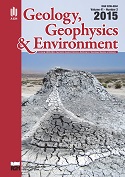Mercury contamination of bottom sediments in water reservoirs of southern Poland
Main Article Content
Keywords
mercury, bottom sediments, reservoirs, geoaccumulation parameters
Abstract
The aim of this study was to assess the mercury concentration in bottom sediments, collected from eight reservoirs located in south-eastern Poland. A DMA-80 Mercury Analyser was used for the analysis of the concentration of mercury in bottom sediments. Concentration of mercury in sediments was between 0.01–0.18 mg∙kg−1. The research results show that 13 samples are above the Polish Hg background level. Only 9 samples are below the background level. Generally, the sediments belonged to class I and II (unpolluted and moderately polluted sediments). The concentration of mercury in bottom sediments follows the order: Rybnik (highest) > Bagna Rzeszowskie > Rzeszów > Ożanna > Brzóza Stadnicka > Brzóza Królewska > Głuchów > Narożniki (lowest). The low mercury content in sediments is related to absent or limited anthropogenic sources of this metal. Elevated concentrations of Hg in bottom sediments of the reservoirs in Rybnik and Bagna Rzeszowskie are related to their proximity to large agglomerations and industrial plants. Organic matter was likely to be the most important factors controlling the concentration and distribution of mercury in the studied sediments.
Downloads
Download data is not yet available.
References
Baran A. & Tarnawski M., 2013. Phytotoxkit/Phytotestkit and Microtox® as tools for toxicity assessment of sediments. Ecotoxicological and Environmental Safety, 98, 19–27.
Baran A., Tarnawski M. & Jasiewicz Cz., 2011. Assessment of the content and solubility of heavy metals in bottom sediments of Chancza reservoir. Ecological Chemistry and Engineering. A., 18, 7, 941–950.
Bojakowska I., Gliwacz T. & Małecka K., 2006. Wyniki geochemicznych badań osadów wodnych Polski w latach 2003–2005. Biblioteka Monitoringu Środowiska, Inspekcja Ochrony Środowiska, Warszawa.
Bojakowska I., 2001. Kryteria oceny zanieczyszczeń osadów wodnych. Przegląd Geologiczny, 49, 3, 213–219.
Boszke L., Głosińska G. & Siepak J., 2002. Some aspect of speciation of mercury in a water environment. Polish Journal of Environmental Studies, 11, 4, 285–298.
Boszke L., Kowalski A, Głosińska G., Szarek R. & Siepak J., 2003. Environmental factors affecting speciation of Mercury in the bottom sediments; an overview. Polish Journal of Environmental Studies, 12, 1, 5–13.
Capri A. & Lindberg S.E., 1997. Sunlight-Mediated Emission of Elemental Mercury from Soil Amended with Municipal Sewage Sludge. Environmental Science Technology, 31, 2085 –2091.
Farkas A., Erratico C. & Vigano L., 2007. Assessment of the environmental significance of heavy metal pollution in surficial sediments of the River Po. Chemosphere, 68, 761–768.
Ferguson J.E., 1990. The heavy elements: chemistry environmental impact and healthy effects. Pergamon Press, Oxford.
Håkanson L., 1980. An ecological risk index for aquatic pollution control. A sedimentological approach. Water Research, 14, 975–1001.
Hintelman H. & Wilken R-D., 1995. Levels of total mercury and methylmercury compounds in sediments of the polluted Elbe River: influence of seasonally and spatially varying environmental factors. Science of Total Environment, 166, 1–3, 1–10.
Kabata-Pendias A. & Pendias H., 1999. Biogeochemia pierwiastków śladowych. PWN, Warszawa.
Koniarz T., Tarnawski M. & Baran A., 2014. Content of lead in bottom sediments of the water reservoir located in urban area. Logistic, 4, 4445–4453.
Lis J. & Pasieczna A., 1995. Atlas geochemiczny Polski: 1:2500000 = Geochemical Atlas of Poland: 1:2500000. Państwowy Instytut Geologiczny, Warszawa.
Müller G., 1981. Die Schwermetallbelastung der Sedimenten des Neckars und seiner Nebenflüsse. Chemiker-Zeitung, 6, 157–168.
Tarnawski M., Florencka N. & Baran A., 2013. Mercury in the Bottom Sediments of the Water Retention Reservoirs. E3S Web of Conferences, 1, 06005.
Milestone productivity tools, [on-line:] http://www.milestonesci.com (access: November 2014).
Baran A., Tarnawski M. & Jasiewicz Cz., 2011. Assessment of the content and solubility of heavy metals in bottom sediments of Chancza reservoir. Ecological Chemistry and Engineering. A., 18, 7, 941–950.
Bojakowska I., Gliwacz T. & Małecka K., 2006. Wyniki geochemicznych badań osadów wodnych Polski w latach 2003–2005. Biblioteka Monitoringu Środowiska, Inspekcja Ochrony Środowiska, Warszawa.
Bojakowska I., 2001. Kryteria oceny zanieczyszczeń osadów wodnych. Przegląd Geologiczny, 49, 3, 213–219.
Boszke L., Głosińska G. & Siepak J., 2002. Some aspect of speciation of mercury in a water environment. Polish Journal of Environmental Studies, 11, 4, 285–298.
Boszke L., Kowalski A, Głosińska G., Szarek R. & Siepak J., 2003. Environmental factors affecting speciation of Mercury in the bottom sediments; an overview. Polish Journal of Environmental Studies, 12, 1, 5–13.
Capri A. & Lindberg S.E., 1997. Sunlight-Mediated Emission of Elemental Mercury from Soil Amended with Municipal Sewage Sludge. Environmental Science Technology, 31, 2085 –2091.
Farkas A., Erratico C. & Vigano L., 2007. Assessment of the environmental significance of heavy metal pollution in surficial sediments of the River Po. Chemosphere, 68, 761–768.
Ferguson J.E., 1990. The heavy elements: chemistry environmental impact and healthy effects. Pergamon Press, Oxford.
Håkanson L., 1980. An ecological risk index for aquatic pollution control. A sedimentological approach. Water Research, 14, 975–1001.
Hintelman H. & Wilken R-D., 1995. Levels of total mercury and methylmercury compounds in sediments of the polluted Elbe River: influence of seasonally and spatially varying environmental factors. Science of Total Environment, 166, 1–3, 1–10.
Kabata-Pendias A. & Pendias H., 1999. Biogeochemia pierwiastków śladowych. PWN, Warszawa.
Koniarz T., Tarnawski M. & Baran A., 2014. Content of lead in bottom sediments of the water reservoir located in urban area. Logistic, 4, 4445–4453.
Lis J. & Pasieczna A., 1995. Atlas geochemiczny Polski: 1:2500000 = Geochemical Atlas of Poland: 1:2500000. Państwowy Instytut Geologiczny, Warszawa.
Müller G., 1981. Die Schwermetallbelastung der Sedimenten des Neckars und seiner Nebenflüsse. Chemiker-Zeitung, 6, 157–168.
Tarnawski M., Florencka N. & Baran A., 2013. Mercury in the Bottom Sediments of the Water Retention Reservoirs. E3S Web of Conferences, 1, 06005.
Milestone productivity tools, [on-line:] http://www.milestonesci.com (access: November 2014).


